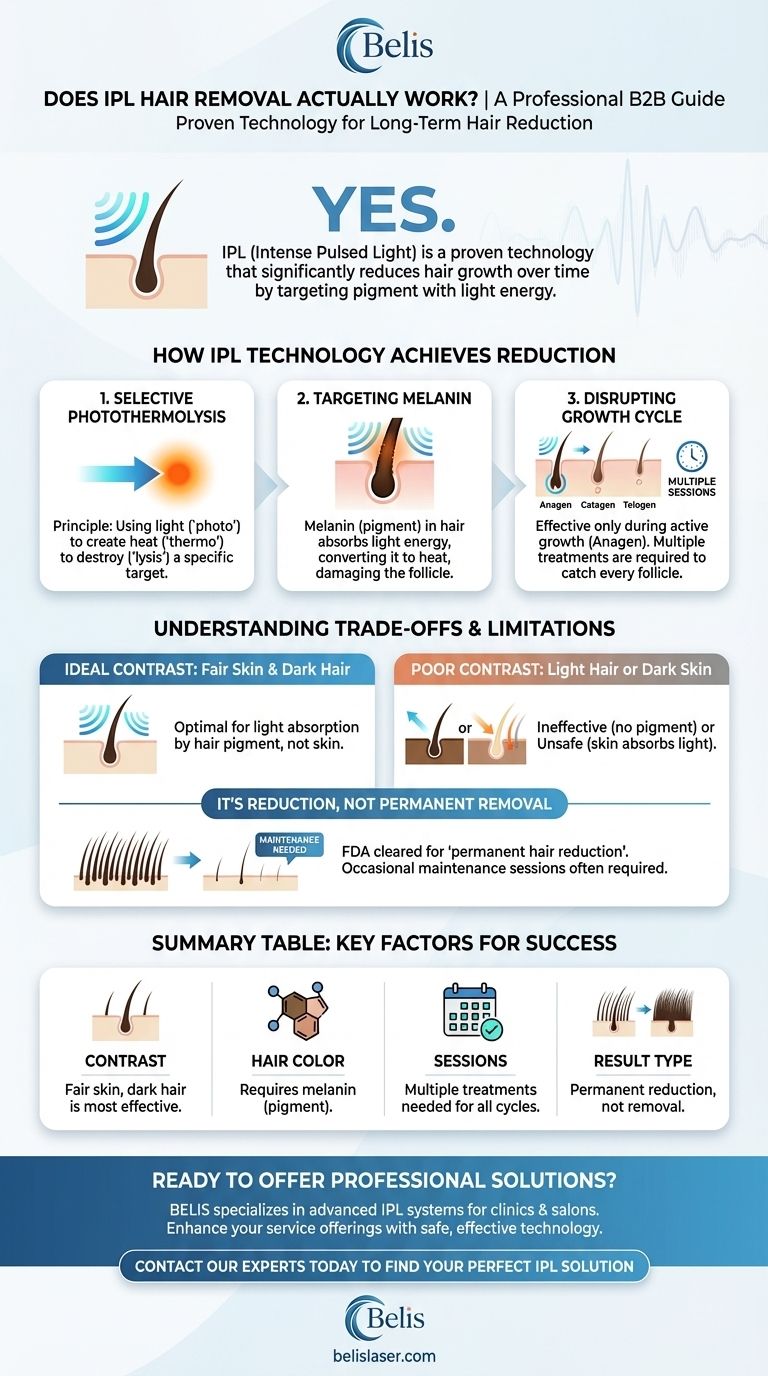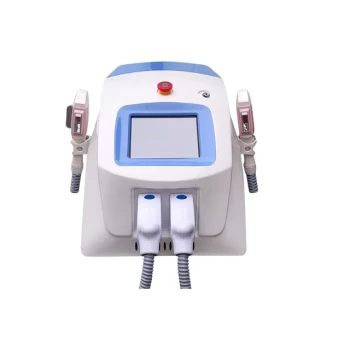Yes, IPL (Intense Pulsed Light) hair removal is a proven technology that effectively reduces hair growth over time. It works by sending pulses of light energy into the skin, which are absorbed by the pigment in the hair follicle. This energy converts to heat, damaging the follicle and putting it into a resting phase, causing the existing hair to fall out and significantly slowing future growth.
The core principle to understand is that IPL provides long-term hair reduction, not permanent hair removal. Its success is highly dependent on the contrast between your skin tone and hair color, as the technology is designed to target the pigment within the hair itself.

How IPL Technology Achieves Hair Reduction
To understand if IPL will work for you, it's essential to understand the mechanism behind it. The process isn't about simply zapping hair away; it's a a specific biological interaction with your hair's growth cycle.
The Principle of Selective Photothermolysis
At its heart, IPL operates on a principle called selective photothermolysis. This is a technical term for a simple concept: using light (photo) to create heat (thermo) to destroy (lysis) a specific target.
In this case, the light energy is precisely calibrated to be absorbed by dark pigment.
Targeting Melanin in the Hair Follicle
The specific target for the light is melanin, the pigment that gives your hair (and skin) its color.
When the light flashes, the melanin in the hair shaft and follicle absorbs this energy intensely, converting it into heat. This controlled thermal damage disrupts the key structures responsible for hair growth without harming the surrounding skin.
Disrupting the Hair Growth Cycle
Hair grows in three phases, but IPL is only effective during the active growth phase (the anagen phase). During this time, the hair is firmly attached to the follicle, creating a perfect pathway for the light energy to travel down and disable the root.
Because only a fraction of your hair is in the anagen phase at any given time, multiple treatments are required. This ensures you can target every follicle during its unique growth cycle.
Understanding the Trade-offs and Limitations
While effective, IPL technology is not a universal solution. Its effectiveness is governed by specific biological factors, and it's crucial to acknowledge these limitations to set realistic expectations.
The Critical Role of Contrast
The ideal scenario for IPL is high contrast: fair skin and dark hair. The technology relies on the light being absorbed by the hair and not the surrounding skin.
If hair is too light (blonde, red, or grey), there isn't enough melanin to absorb the light, making the treatment ineffective. Conversely, if skin is very dark, it contains a high concentration of melanin and can absorb the light energy, which is inefficient and poses a risk of burns or discoloration.
It's Hair Reduction, Not Permanent Removal
The FDA has cleared IPL devices for "permanent hair reduction." This is a crucial distinction.
Over a full course of treatment, IPL can permanently disable a majority of hair follicles. However, hormonal changes or other factors can sometimes reactivate follicles, leading to some regrowth. Most users find they need occasional maintenance sessions (e.g., once or twice a year) to maintain smooth results.
A Replacement for Shaving and Waxing
IPL is designed to replace the endless cycle of traditional hair removal methods.
While shaving cuts hair at the surface and waxing pulls it from the root, both are temporary solutions that must be repeated constantly. IPL offers a way to break that cycle by fundamentally reducing the amount of hair your body grows in the treated area.
Making the Right Choice for Your Goal
Deciding on a hair removal method depends entirely on your goals, patience, and biological profile.
- If your primary focus is significant, long-term hair reduction: IPL is an excellent choice, provided you have a suitable contrast between your skin and hair color.
- If you have fair hair (blonde, grey) or very dark skin: IPL will likely be ineffective or unsafe, and you should explore alternatives like electrolysis for a more permanent solution.
- If your primary focus is immediate, short-term hair removal: Traditional methods like shaving or waxing remain the most practical and effective options.
By understanding how IPL works and for whom it works best, you can make an informed decision aligned with your personal needs.
Summary Table:
| Key Factor | Why It Matters for IPL Success |
|---|---|
| Skin & Hair Contrast | Most effective on fair skin with dark hair for optimal light absorption. |
| Hair Color | Requires pigment (melanin). Not effective on blonde, red, or grey hair. |
| Treatment Sessions | Multiple sessions are needed to target all hair follicles in their growth cycle. |
| Result Type | Provides permanent hair reduction, not always complete permanent removal. |
Ready to offer professional, long-lasting hair removal solutions to your clients?
BELIS specializes in professional medical aesthetic equipment, serving medical aesthetics clinics and premium beauty salons. Our advanced IPL systems are designed for safety, efficacy, and superior client results, helping you enhance your service offerings and grow your business.
Contact our experts today to find the perfect IPL solution for your clinic.
Visual Guide

Related Products
- IPL SHR Hair Removal Machine for Permanent Hair Removal
- Clinic Use IPL and SHR Hair Removal Machine with Nd Yag Laser Tattoo Removal
- IPL SHR+Radio frecuency machine
- Clinic Use IPL SHR ND YAG Laser Hair Removal RF Skin Tightening Machine
- Diode Tri Laser Hair Removal Machine for Clinic Use
People Also Ask
- Can IPL be used on all skin types? Understanding Risks for Darker Skin Tones
- Does IPL work on all skin types? The critical role of the Fitzpatrick scale in safety and results
- Can you use hair removal device on private parts? A Guide to Safe Bikini Area IPL
- What should I look for in an IPL machine? Key Features for Effective Hair Removal
- What is intense pulsed light good for? A Versatile Solution for Sun Spots, Redness, and Hair



















